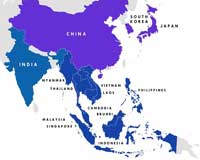"Asean took shape on August 8, 1967, the Association of Southeast Asian Nations, ASEAN, was comprised Indonesia, Philippines, Malaysia, Singapore, and Thailand and today it has expanded to Cambodia, Lao PDR, Brunei Darussalam, Myanmar, and Vietnam. The intent of the association formed between ten Southeast Asian countries was to promote inter-country trade, governmental cooperation, and economic, political and socio-cultural integration of the member countries, and globally. Additionally, it also aims to protect the member states’ regional stability and instill peace amongst them in times of conflict resolution. In 2015, ASEAN organization’s nominal GDP (combined) was around $2.8 trillion, making it a global powerhouse."
 Asean took shape on August 8, 1967, the Association of Southeast Asian Nations, ASEAN, was comprised Indonesia, Philippines, Malaysia, Singapore, and Thailand and today it has expanded to Cambodia, Lao PDR, Brunei Darussalam, Myanmar, and Vietnam. The intent of the association formed between ten Southeast Asian countries was to promote inter-country trade, governmental cooperation, and economic, political and socio-cultural integration of the member countries, and globally. Additionally, it also aims to protect the member states’ regional stability and instill peace amongst them in times of conflict resolution. In 2015, ASEAN organization’s nominal GDP (combined) was around $2.8 trillion, making it a global powerhouse. ASEAN shares its physical borders with major apparel trade giants like India, China, and Bangladesh. It has been the foundation of several establishments like East Asia Summit, EAS, and Regional Comprehensive Economic Partnership, RCEP (FTA between ASEAN, Australia, China, Japan, South Korea, New Zealand and India).
Asean took shape on August 8, 1967, the Association of Southeast Asian Nations, ASEAN, was comprised Indonesia, Philippines, Malaysia, Singapore, and Thailand and today it has expanded to Cambodia, Lao PDR, Brunei Darussalam, Myanmar, and Vietnam. The intent of the association formed between ten Southeast Asian countries was to promote inter-country trade, governmental cooperation, and economic, political and socio-cultural integration of the member countries, and globally. Additionally, it also aims to protect the member states’ regional stability and instill peace amongst them in times of conflict resolution. In 2015, ASEAN organization’s nominal GDP (combined) was around $2.8 trillion, making it a global powerhouse. ASEAN shares its physical borders with major apparel trade giants like India, China, and Bangladesh. It has been the foundation of several establishments like East Asia Summit, EAS, and Regional Comprehensive Economic Partnership, RCEP (FTA between ASEAN, Australia, China, Japan, South Korea, New Zealand and India).
Free trade agreements
Free Trade Agreements within ASEAN countries are led by the ASEAN Trade in Goods Agreement (ATIGA) and the Agreement on Customs. The ASEAN Free Trade Area (AFTA) is a trade bloc agreement, which launched the Common Effective Preferential Tariff Scheme (CEPT). CEPT states that the tariff will be reduced to 0-5 per cent, on the goods being traded within ASEAN region, if the goods meet a 40 per cent ASEAN content requirement. Apart from the establishment of AFTA within the member states, ASEAN trade bloc has also signed various free trade agreements with major Asia-Pacific economies, such as ASEAN-China FTA (ACFTA), ASEAN-Australia-New Zealand FTA (AANZFTA), ASEAN-Korea FTA (AKFTA), ASEAN-India FTA (AIFTA), and ASEAN-Japan Comprehensive Economic Partnership (AJCEP). These FTAs encourage and promote businesses in the ASEAN trade bloc, irrespective of their size, by enabling regional and international trade without any tariff barriers. They also offer businesses an easy access to the new export markets with simplified import and export.
the Agreement on Customs. The ASEAN Free Trade Area (AFTA) is a trade bloc agreement, which launched the Common Effective Preferential Tariff Scheme (CEPT). CEPT states that the tariff will be reduced to 0-5 per cent, on the goods being traded within ASEAN region, if the goods meet a 40 per cent ASEAN content requirement. Apart from the establishment of AFTA within the member states, ASEAN trade bloc has also signed various free trade agreements with major Asia-Pacific economies, such as ASEAN-China FTA (ACFTA), ASEAN-Australia-New Zealand FTA (AANZFTA), ASEAN-Korea FTA (AKFTA), ASEAN-India FTA (AIFTA), and ASEAN-Japan Comprehensive Economic Partnership (AJCEP). These FTAs encourage and promote businesses in the ASEAN trade bloc, irrespective of their size, by enabling regional and international trade without any tariff barriers. They also offer businesses an easy access to the new export markets with simplified import and export.
Competitive edge
ASEAN countries do not face a high degree of competition for consumer and finished products, and product diversification has enabled ASEAN economies to aggressively export to the global textile & apparel market. The process of trade liberalization through AFTA, various FTAs and the ASEAN Economic Community’s creation in 2015, has not only led to tariff reduction and elimination but also in integration and elimination of the non-tariff barriers that ASEAN players face in the industry. Owing to this advantage, exports value of ASEAN5 including Malaysia, Thailand, Indonesia, Philippines and Vietnam nearly tripled from $24.4 billion in 2001 to $71.8 billion in 2014. The biggest gainer has been Vietnam with a 10-fold increase in the apparel and textile exports value in the same time period. Apart from the ASEAN advantage, Vietnam’s accession to the World Trade Organization (WTO), 2007 was also an additional factor that allowed Vietnam to export to larger markets without tariff barriers.
India ties
In 2010, India achieved a milestone to expand its economic and political relationship with its neighbours, through the ASEAN-India FTA (AIFTA). This agreement resulted in duty liberalisation between India and ASEAN countries to enhance bilateral trade. Under AIFTA, each trading partner can keep some products out of the agreements, till the time they amount to less than 5 per cent of bilateral traded imports. This FTA can trigger a positive trade between India and ASEAN countries. The agreement set tariff liberalisation on over 90 per cent products traded between India and ASEAN. Additionally, AIFTA can also bring in investments from ASEAN textile manufacturers in the Indian manufacturing sector, catering both to the country’s domestic and export markets.












